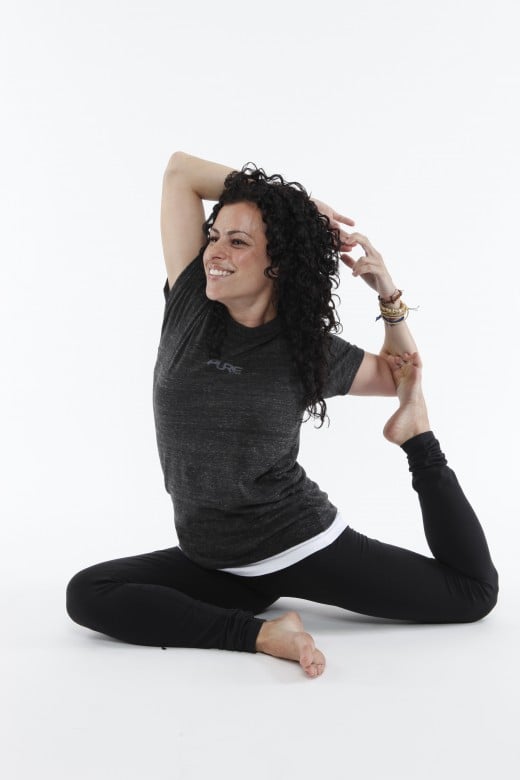Pigeon Pose, Eka Pada Rajakapotasana

The Pigeon Pose or Kapotasana can be done in many variations according to the different levels ability of the students. One variation is the Eka Pada Rajakapotasana which is the One-legged King Pigeon Pose and is an intense backbend yoga pose. It has to be performed after having attained a certain amount of flexibility by practicing beginning yoga poses for some weeks. To begin with the leg position can be attempted only by the most experienced beginners before going on to the advanced pose.
The Sanskrit name for the pose eka pada rajakapotasana means:
eka = one
pada = foot or leg
raja = king or royal
kapota = pigeon or dove
The One-legged Pigeon Pose or eka pada rajakapotasana is intermediate and advanced level yoga pose.
Benefits of the Pigeon Pose
This pose like other backbends has many benefits:
- massages and stimulates the kidneys
- opens the hip area and chest
- aligns the pelvis
- stretches the thighs, hip flexors and hip rotators
- increases circulation to the pelvic floor
Beginner - Pigeon Pose
Beginner and Intermediate - Pigeon Pose
How to do the Pigeon Pose – For Experienced Beginners
This pose focusing on the leg position is suitable for most experienced beginners:
- Start with 'table position' on all fours with your arms under your shoulders and knees under your hips
- you can also start with the downward dog position as well.
- Cross your left foot in front of the right knee. Slide and lengthen your right leg straight back. If the stretch is too intense, place a pillow under your left hip.
- Move the right side of your chest slightly to the left to align the hips, then lower your chest onto your left leg. Align your elbows under your shoulders.
- Stay in the comfort zone as your feel a stretch in the hip.
- Place both hands under your shoulders; press into the floor and lift the upper torso, raising your chest like a 'pigeon'. Keep your shoulders down and away from the ears.
- Make sure you do not experience any compression in your lower back.
- Releasing from the pose:
- To release come up onto your right knee or shinbone. Uncross your left leg, straighten it behind you, and shake the leg and foot a few times.

Intermediate - King Pigeon Pose
How to do the One-Legged King Pigeon Pose – Intermediate and Advanced
This pose is an intense backbend and must not be attempted by beginners. In this variation suitable for intermediate and advanced level students the full backbend is achieved:
- Do the above variation in preparation for the King Pigeon.
- Get into Pigeon Pose as above with your back upright
- Start to bring the shin of your leg which is in front more parallel with the front of the mat.
- Bend the knee of the leg that is stretched behind.
- Draw the foot into the crook of the elbow of the arm on the same side
- Reach the other arm up, and clasp your hands behind your head.
- In the more advanced version you will be able to grab your foot with both your hands and touch your head to the foot.
There are altogether three variations to the yoga Pigeon Pose or Kapotasana called:
- Rajakapotasana – King Pigeon Pose
- Eka Pada Rajakapotasana – One-legged King Pigeon Pose
- Salamba Kapotasana – Supported Pigeon Pose
Achieving the full pose is an adventure and is a good challenge to give oneself in the personal yoga practice.
Resources for Preparing for Pigeon Pose
- Beginning Yoga Poses
Regular practice of yoga poses builds up the body's inner strength and natural resistance, improves muscle tone and removes toxins. Find out some of the beginners yoga poses. - Yoga Poses for Shoulders
The challenges of our life can cause stress and tension in our shoulders and neck muscles. Find out how to relax and strengthen the shoulders through yoga poses. - Yoga Poses for Legs
Our legs are the most important parts of the body. They support our body weight, help us walk, run, swim, stand and be active in our lives. Yoga is a great way to maintain muscle tone of the legs. - How to Improve Flexibility of Tight Hamstrings with ...
Did you know that tight hamstrings can cause many injuries, poor posture, inhibit movement, and back pain? Learn how to loosen your hamstrings with yoga and improve performance in sports and daily life. - How to Perform the Locust Pose in Yoga
The half locust and the full locust pose in yoga are both beneficial to strengthen the buttocks, legs and increase energy and circulation in the body. Learn how to perform both the variations. - Yoga Poses for the Spine
The spine is like the trunk of a tree, supporting the entire body structure. Taking care of it and maintaining its strength and flexibility is of primary importance. Find out some of the yoga poses that you can incorporate into your yoga practice.








